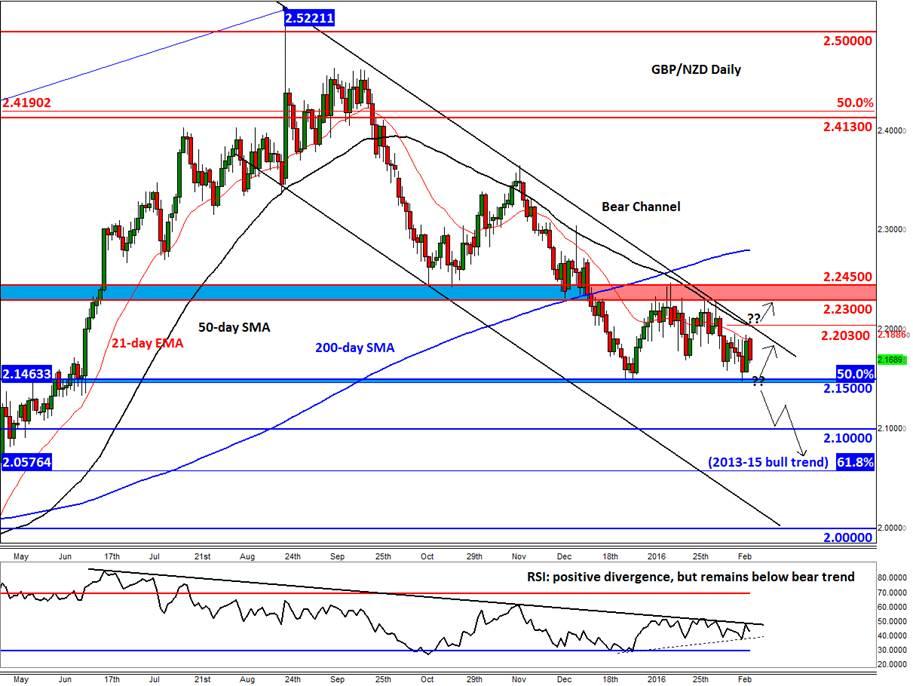![]()
This week’s sheer number of top-tier economic data from the UK economy means the focus will be on sterling, which has been pounded recently because of receding expectations about a Bank of England rate rise this year. In fact, as my colleague Matt Weller reported earlier, contrary to economists’ expectations of a rate rise, traders have actually started to expect a rate cut as the more likely scenario. Their conviction is only likely to grow should this week’s UK macroeconomic data disappoint expectations. Indeed, given the current sentiment and the so-called “Brexit” risks, it would probably require some significantly stronger data to change the market’s perception, which appears unlikely. So, while there is a possibility for a respite in the selling pressure, things could go from bad to worse for the pound, especially against currencies where the central bank is more hawkish, such the Australian and New Zealand dollars. Both the RBA and RBNZ appear content with the recent weakness of their respective currencies and also the current level of interest rates. In New Zeeland, interest rates are significantly higher at 2.5% than most other developed nations. The GBP/NZD could therefore weaken a lot further over the long term outlook if the disparity between the RBNZ and BoE’s policies grow. In the very short-term outlook, the GBP/NZD could also suffer if UK’s data disappoints and/or (2) macro pointers from New Zealand beat expectations this week. Otherwise, a short-term relief rally could be on the cards.
This week’s key UK data include:
- Tuesday: CPI (09:30 GMT)
- Wednesday: average hourly earnings, claimant count, unemployment rate (09:30 GMT)
- Friday: retail sales (09:30 GMT)
- Tonight: retail sales (21:45 GMT)
- Tuesday: quarterly inflation expectations (2:00 GMT), GDT price index (Tentative)
- Wednesday: PPI input & output (21:45 GMT)
In the event of a break below the 2.1500 support level, there are not much further short-term reference points seen until 2.1000, which was formerly resistance. So, there’s scope for a sharp drop in the GBP/NZD this week. Below 2.1000, the next potential bearish target could be the 61.8% Fibonacci retracement of the entire 2013-15 upswing, at 2.0575, or even the lower trend of the bearish channel and psychological at 2.0000.
On the other hand, a decisive break above the resistance trend of the bearish channel and the 50-day moving around 2.0230 could pave the way for a sharp rally. The GBP/NZD’s next move above 2.0230 would then depend on what it will do around the key resistance area between 2.2300 and 2.24500. But as things stand, the more likely outcome is a breakdown than a breakout.

Trading leveraged products such as FX, CFDs and Spread Bets carry a high level of risk which means you could lose your capital and is therefore not suitable for all investors. All of this website’s contents and information provided by Fawad Razaqzada elsewhere, such as on telegram and other social channels, including news, opinions, market analyses, trade ideas, trade signals or other information are solely provided as general market commentary and do not constitute a recommendation or investment advice. Please ensure you fully understand the risks involved by reading our disclaimer, terms and policies.
Recommended Content
Editors’ Picks
EUR/USD edges lower toward 1.0700 post-US PCE

EUR/USD stays under modest bearish pressure but manages to hold above 1.0700 in the American session on Friday. The US Dollar (USD) gathers strength against its rivals after the stronger-than-forecast PCE inflation data, not allowing the pair to gain traction.
GBP/USD retreats to 1.2500 on renewed USD strength

GBP/USD lost its traction and turned negative on the day near 1.2500. Following the stronger-than-expected PCE inflation readings from the US, the USD stays resilient and makes it difficult for the pair to gather recovery momentum.
Gold struggles to hold above $2,350 following US inflation

Gold turned south and declined toward $2,340, erasing a large portion of its daily gains, as the USD benefited from PCE inflation data. The benchmark 10-year US yield, however, stays in negative territory and helps XAU/USD limit its losses.
Bitcoin Weekly Forecast: BTC’s next breakout could propel it to $80,000 Premium

Bitcoin’s recent price consolidation could be nearing its end as technical indicators and on-chain metrics suggest a potential upward breakout. However, this move would not be straightforward and could punish impatient investors.
Week ahead – Hawkish risk as Fed and NFP on tap, Eurozone data eyed too

Fed meets on Wednesday as US inflation stays elevated. Will Friday’s jobs report bring relief or more angst for the markets? Eurozone flash GDP and CPI numbers in focus for the Euro.